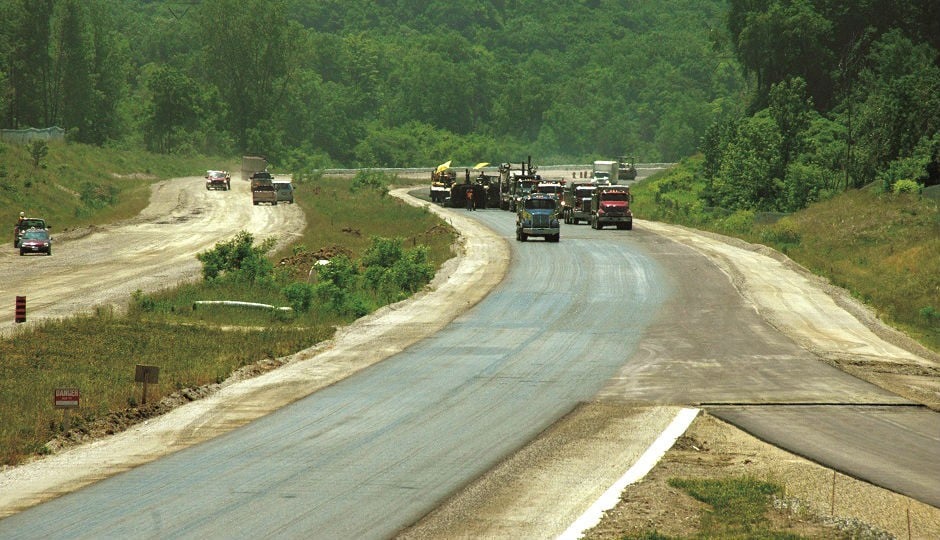
A perpetual pavement is a multi-layer design consisting of a renewable surface layer, a strong, rut-resistant intermediate layer, and a flexible, fatigue resistant rich-bottom layer.
Designed to last a minimum of 50 years, perpetual pavements initially cost approximately 30 percent more than conventional road structures but deliver numerous advantages, notably reduced costs for road rehabilitation over the long term.
The top renewable layer will be periodically replaced to prevent top-down cracking to the lower binder layer. Both the middle, rut-resistant layer and bottom fatigue-resistant layer are built to remain in place during the full 50-year design life of the pavement.
The bottom fatigue-resistant layer, not present in a conventional pavement, minimizes the tensile strain at the bottom of the structure and prevents fatigue cracking. Another option is to design this bottom layer as a rich-bottom mix (RBM), which increases the strain resistance of the base layer by adding additional asphalt cement (about 0.5 percent) to a standard Superpave mix.
With only the top layer of a pavement to maintain and replace, construction work and length of traffic disruptions are kept to a minimum during service, thereby significantly reducing greenhouse gas emissions associated with idling vehicles. Fewer rehabilitation projects also save on the depletion of virgin materials, the energy needed to produce those materials, and the wear and tear on road construction equipment.
Trial projects by MTO
In an effort to promote sustainability in the design, construction and maintenance of highway infrastructure, Ontario’s Ministry of Transportation (MTO) has initiated a series of perpetual pavement trial projects on trial projects on Highway 401 near Woodstock; Highway 7 at Carleton; and Highway 406 near Thorold. The 401 project is a high profile study that includes instrumentation to monitor and measure pavement performance. The MTO has partnered with the Centre for Pavement and Transportation Technology (CPATT) at the University of Waterloo and with OHMPA to install, collect and analyze data from the monitoring stations. The findings will help to provide a better understanding of how different pavement structures react and perform under various traffic loadings and environmental conditions.
Highway 401
The 401 project is comprised of a 15- km stretch of highway that is divided into three segments for comparative purposes. There is an 11-km, 300-mm-thick conventional pavement that is flanked by two perpetual pavements, each two kilometres long. Both perpetual pavements are 420 mm thick, but have different lower binder layers – one with a conventional Superpave 25 mm design and the other designed as an RBM with 0.5 percent more asphalt cement added to the Superpave 25 mm mix. To measure tensile strain, asphalt strain gauges were installed at the bottom of the asphalt layers under the wheel path in each segment. Additional instrumentation in each segment included temperature gauges in each layer of pavement, earth pressure cells to measure the vertical pressure at subgrade level, and moisture probes to measure subgrade moisture levels.
Following two years of data collecting, results confirm that the perpetual pavement sections of the project are outperforming the conventional pavement, with the RBM section showing the lowest tensile strain at the bottom of the asphalt layers. The tensile strain is below the 70 microstrain threshold, with field analysis validating fatigue cracking and rutting models.
“The RBM has only 0.5 percent increase in binder, so it will take some time to see if it performs better than the perpetual pavement without the additional asphalt cement,” says Mohab El-Hakim, PhD, who led the CPATT monitoring and analysis of the Highway 401 project and who is currently a pavement engineer at Stantec. “I expect insignificant performance variation among both designs within the first 10 years of service-life. With perpetual pavements, you want to eliminate bottom-up cracks and limit all cracking to the topdown cracks.”
Monitoring sensors within pavement response systems are designed to last three to five years, which prevents any long term collection of data. Still, the systems deliver a body of information that details the effects of freeze/thaw cycles, ambient temperature spikes, and traffic stress patterns over several seasons. The data provides engineers with a higher level of accuracy and confidence in designing perpetual pavements, and the ability to customize those designs to achieve 50-year performance. The 401 perpetual pavement trial project continues to be monitored by MTO using their Automated Road Analyser (ARAN) with 3D scanning, which carries out annual roughness and rutting surveys.
Six years post-construction, the surface layers of all three pavements show the same performance, with an impressive International Roughness Index (IRI) of 0.6 m/km. “We’re still very early in the evaluation period, but strain gauge measurements show that the perpetual pavements have less stress in the bottom layers, which will prevent bottom-up cracking,” says Becca Lane, materials, engineering and research manager at MTO. “While the strain readings on the perpetual pavements are lower, all test sections have the same IRI of 0.6 m/km, which is a very good rating for performance.”
Highway 406
The Highway 406 Thorold project, completed in 2007, is MTO’s first perpetual pavement trial. A 5-km section of the four-lane divided freeway slated for rehabilitation was originally designed as a conventional deep strength, flexible pavement. The decision to construct a perpetual pavement was incorporated into the project near the end of its design stage, which required modifications. The perpetual pavement concept was incorporated by adding 80 mm of RBM, and the total thickness of the perpetual pavement structure was adjusted to conform to the profile grade of the original design, resulting in a total asphalt thickness of 250 mm. The control section of conventional asphalt pavement is 200 mm thick. To design the RBM, the original Superpave 25 mm mix designed with 4.3 percent asphalt cement was adjusted to incorporate a higher asphalt cement content of 4.7 percent. This pavement has no instrumentation, but subsequent ARAN surveys show that the seven year old pavement has an IRI of 1.5 m/km and shows very little rutting with a rut depth of 3.3 mm.
“This pavement trial is exciting because it has both a perpetual pavement and a conventional pavement to compare it to,” Lane says. “As the first perpetual pavement project, we were focused on the constructability of a perpetual pavement and how we could get more asphalt cement into the bottom mix. We analyze both the perpetual pavement and the control every year and, so far, both sections are performing well.”
Highway 7
Constructed in 2009, the MTO Highway 7 Carleton Place perpetual pavement project is also performing well. Schedulled for rehabilitation, the 17 km stretch of highway was expanded from two lanes to four lanes, with the entire section designed as a perpetual pavement. The RBM base layer is 80 mm and was designed as a Superpave 25 mm mix, with an additional 0.4 asphalt cement. This trial project was not instrumented, but has an IRI of 0.9 m/ km and is performing as expected.
Hamilton project
The Red Hill Valley Parkway (RHVP) in Hamilton is a prime example of how municipalities can incorporate perpetual pavements into their rehabilitation and new build programs. The RHVP is an eightkilometre, four-lane controlled access highway that is a part of the link between Highway 403 and the Queen Elizabeth Way, providing motorists with a convenient and efficient north/south route to access these arterial highways.
At the time that construction commenced in 2003, the concept of designing perpetual pavements was still relatively new; however, the opportunity to build a long-lasting, 50-year pavement was a good fit with Hamilton’s priority to reduce life cycle costs and to protect the natural environment of the Red Hill Valley. A perpetual pavement would minimize traffic disruptions and avoid exhaust emissions from stop-and-go traffic.
The design of the RHVP pavement includes 80 mm RBM of modified Superpave 19 mm, with an additional 0.5 percent of asphalt cement. The binder course has 70 mm of Superpave 25 mm and 50 mm of Superpave 19 mm. The 40 mm wearing course is an SMA mix, which offers good friction and resistance to cracking. In order to verify the performance of the pavement materials, a pavement response system was installed, as well as a traffic monitoring system which collects data about the number of vehicles, speed, spacing and loading of the vehicles.
“Compared to others, the RHVP has a relatively thin perpetual pavement with a 240 mm surface layer, rather than the usual 300 mm,” says Gary Moore, director of engineering services for the City of Hamilton. “The program showed that we only needed 240 mm, so it didn’t make economic sense to make the pavement thicker. Under the bridge, we had only five metres, so there were space constraints as well.”
When the RHVP opened in 2007, and data from the pavement monitoring station was analysed, it was apparent that the highway’s perpetual pavement had exceeded expectations. “The pavement was designed to handle 90,000 vehicles per day at the 50-year mark, but as soon as the highway opened, we were seeing 70,000 to 80,000 per day, right away,” says Ludomir Uzarowski, a principal at Golder Associates Ltd. in Mississauga and Senior Pavement and Materials Engineer. “The opening of the RHVP drastically changed the traffic pattern in the city. Motorists found it to be a very handy short-cut, so traffic was much higher than we expected.”
Collected data showed that, despite heavier traffic levels and evidence of overloaded trucks, the pavement did not display an extreme response, with the horizontal strain at the bottom of the HMA layers below the 70 microstrain threshold. The compressive strain of the top of the subgrade layer was also lower than the limit of 200 microstrains, confirming that the pavement is rut resistant.
“Our concern was for the spring thaw, when the strain is increased, but the sensors showed that the tensile strain was below 70 microstrains,” Uzarowski says. “We know that the pavement won’t crack from the bottom up, which makes it a perpetual pavement. The pavement monitoring system gave enough information to confirm that this was a good pavement design.”
“Long closures for major rehabilitation work would be a nightmare, affecting 80,000 vehicles per day,” Moore says. “The crossovers we’d have to create would cost $1 million alone in traffic controls. With a perpetual pavement, we’ll only have to replace the surface layer every 20 years. We can do this at night, with minimum disruption to motorists.”
Lisa Fattori is a freelance writer, specializing in the construction industry. The original article appeared in the Spring issue of Asphaltopics, the official publication of the Ontario Hot Mix Producers Association (OHMPA).


